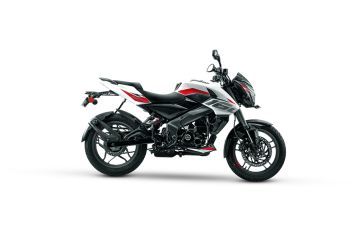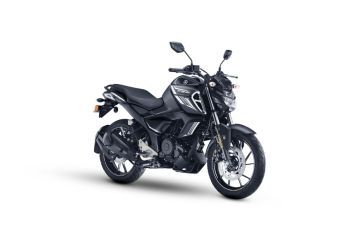Explore all New Cars of 2025
Bajaj Pulsar NS160 vs Yamaha FZS-FI V3
Pulsar NS160 vs FZS-FI V3
| Key Highlights | Pulsar NS160 STD | FZS-FI V3 Matte Red And Matte Grey |
|---|---|---|
| Engine Type | Oil Cooled, Twin Spark, 4-Valve FI DTS-i | Air cooled, 4-stroke, SOHC, 2-valve |
| Max Power | 17.2 PS @ 9000 rpm | 12.4 PS @ 7250 rpm |
-
Bajaj Pulsar NS160
 Rs. 1.47 Lakh EMI - Rs. 4,400 View January OffersYamaha FZS-FI V3
Rs. 1.47 Lakh EMI - Rs. 4,400 View January OffersYamaha FZS-FI V3 Rs. 1.22 Lakh EMI - Rs. 3,541 View January Offers
Rs. 1.22 Lakh EMI - Rs. 3,541 View January Offers
Pulsar NS160 vs FZS-FI V3 Key Highlights
| Basic Info | Bajaj Pulsar NS160 STD | Yamaha FZS-FI V3 Matte Red And Matte Grey |
|---|---|---|
| Rating |
328 reviews
|
534 reviews
|
| Brand Name | Bajaj | Yamaha |
| Ex-Showroom Price | Rs. 1.47 Lakh Get On-Road Price | Rs. 1.22 Lakh Get On-Road Price |
| Engine Type | Oil Cooled, Twin Spark, 4-Valve FI DTS-i | Air cooled, 4-stroke, SOHC, 2-valve |
| Max Power | 17.2 PS @ 9000 rpm | 12.4 PS @ 7250 rpm |
| Fuel Type | Petrol | Petrol |
| Colors | ||
| Brakes Front | Disc | Disc |
| Brakes Rear | Disc | Disc |
| Wheel Size | Front :-431.8 mm,Rear :-431.8 mm | Front :-431.8 mm,Rear :-431.8 mm |
| Wheels Type (Pressed Steel/ Alloy) | Alloy | Alloy |
| ABS | Dual Channel | Single Channel |
| Starting | Self Start Only | Self Start Only |
| Speedometer | Digital | Digital |
| EMI |
Rs. 4,400
@
11.99% (36 months)
|
Rs. 3,541
@
9.45% (36 months)
|
| Insurance | Rs. 11,165 Pulsar NS160 Insurance | Rs. 7,161 FZS-FI V3 Insurance |
| Brochure |
Download
Brochure
|
Download
Brochure
|
Engine |
|
||||||||||||||||||||||||||||||||||||||||||||||||||||||||||||
|---|---|---|---|---|---|---|---|---|---|---|---|---|---|---|---|---|---|---|---|---|---|---|---|---|---|---|---|---|---|---|---|---|---|---|---|---|---|---|---|---|---|---|---|---|---|---|---|---|---|---|---|---|---|---|---|---|---|---|---|---|---|
Brakes |
|
||||||||||||||||||||||||||||||||||||||||||||||||||||||||||||
Performance |
|
||||||||||||||||||||||||||||||||||||||||||||||||||||||||||||
Tyres |
|
||||||||||||||||||||||||||||||||||||||||||||||||||||||||||||
Dimensions |
|
||||||||||||||||||||||||||||||||||||||||||||||||||||||||||||
Electricals |
|
||||||||||||||||||||||||||||||||||||||||||||||||||||||||||||
Features |
|
Pros and Cons
- Positives
- Negatives
- It packs a pretty powerful engine
- Shares the capable perimeter frame with larger Pulsars
- Stopping power is pretty good.
- Big bike styling
- features
- smooth engine.
- Engine refinement could have been better
- It isn’t feature-rich like its segment rivals
- It is the heaviest 160cc motorcycle.
- Performance isn’t up to the mark
- the quality of plastics feels sub-par.
Is Bajaj Pulsar NS160 Better Than Yamaha FZS-FI V3?
57% users have chosen Bajaj Pulsar NS160 over Yamaha FZS-FI V3 in a survey being conducted on zigwheels.com.
Apart from this survey a total of 2882 users have also rated Bajaj Pulsar NS160 and Yamaha FZS-FI V3 on some really important factors like Mileage , performance, comfort, safety etc. and have given their personal opinions about these bikes.
As per the users experiences Bajaj Pulsar NS160 is a winner for you if you are seriously looking for performance, maintenance and features in your bike. But Yamaha FZS-FI V3 is better on the grounds of mileage and comfort.
Before making your decision you should also consider the unbiased and thorough analysis of these bikes on every aspect by our auto experts who have summarised the analysis in pros, cons and final conclusion..
| Ratings Factor | FZS-FI V3 | Pulsar NS160 |
|---|---|---|
| Mileage | 3.8 | 4.3 |
| Performance | 4.4 | 4.2 |
| Comfort | 4.2 | 4.4 |
| Maintenance | 3.9 | 3.8 |
| Features | 4.4 | 4.3 |
Videos of Bajaj Pulsar NS160 and Yamaha FZS-FI V3
-
2023 Bajaj Pulsar NS200 And Pulsar NS160 First Ride Review - Road + Track | USD Fork Added 25 Mar, 2023 18596 views
-
160cc Sporty Commuters Compared On Acceleration, Fuel Efficiency, Price And Features | ZigWheels 30 May, 2023 5362 views
-
2023 Bajaj Pulsar NS160 & Pulsar NS200 Walkaround | Revised hardware, new features and…? | Zigwheels 14 Mar, 2023 7121 views
-
Bajaj Pulsar NS 160 (2017) : The Good And The Bad : PowerDrift 15 Aug, 2017 465732 views
-
Bajaj Pulsar NS160 (2017) : First Look : PowerDrift 16 Jul, 2017 283096 views
-
DIY: How to Lube your chain: PowerDrift 7 May, 2014 74821 views
-
Traction Control For Yamaha FZ-S Fi Version 4.0, FZ-X, R15 M, MT-15 V2 | Price & Features | Zigwheels 14 Feb, 2023 8908 views
Bajaj Pulsar NS160 Comparison with Similar Bikes
-
 BajajPulsar NS160Rs. 1.47 LakhvsPulsar NS160 vs Apache RTR 160 4V
BajajPulsar NS160Rs. 1.47 LakhvsPulsar NS160 vs Apache RTR 160 4V TVSApache RTR 160 4VRs. 1.24 Lakh
TVSApache RTR 160 4VRs. 1.24 Lakh
yamaha fz s fi version 3 Comparison with Similar Bikes
-
 YamahaFZS-FI V3Rs. 1.22 LakhvsFZS-FI V3 vs Apache RTR 160 4V
YamahaFZS-FI V3Rs. 1.22 LakhvsFZS-FI V3 vs Apache RTR 160 4V TVSApache RTR 160 4VRs. 1.24 Lakh
TVSApache RTR 160 4VRs. 1.24 Lakh -
 YamahaFZS-FI V3Rs. 1.22 LakhvsFZS-FI V3 vs FZ-FI Version 3.0
YamahaFZS-FI V3Rs. 1.22 LakhvsFZS-FI V3 vs FZ-FI Version 3.0 YamahaFZ-FI Version 3.0Rs. 1.17 Lakh
YamahaFZ-FI Version 3.0Rs. 1.17 Lakh
Latest News on Bajaj Pulsar NS160 and Yamaha FZS-FI V3
-
 Bajaj Pulsar NS160 Flex Fuel Showcased At IBET (India Bio-Energy And Tech) Expo 20244 Sep, 2024 | By Team ZigWheels
Bajaj Pulsar NS160 Flex Fuel Showcased At IBET (India Bio-Energy And Tech) Expo 20244 Sep, 2024 | By Team ZigWheels -
 Yamaha Announces Festive Offers For FZ-Fi, FZ-S Fi V3 and V4, Fascino And RayZR 125 Fi Hybrid26 Sep, 2024 | By Team ZigWheels
Yamaha Announces Festive Offers For FZ-Fi, FZ-S Fi V3 and V4, Fascino And RayZR 125 Fi Hybrid26 Sep, 2024 | By Team ZigWheels -

-
 Yamaha FZ-S FI V4 vs TVS Apache RTR 160: Features Compared20 Feb, 2023 | By Team ZigWheels
Yamaha FZ-S FI V4 vs TVS Apache RTR 160: Features Compared20 Feb, 2023 | By Team ZigWheels -
 2024 Bajaj Pulsar NS160 And Pulsar NS200 Launched27 Feb, 2024 | By Team ZigWheels
2024 Bajaj Pulsar NS160 And Pulsar NS200 Launched27 Feb, 2024 | By Team ZigWheels -
 Yamaha FZ-S V4 Vs FZ-S V3: New Vs Old In 5 Pics13 Feb, 2023 | By Team ZigWheels
Yamaha FZ-S V4 Vs FZ-S V3: New Vs Old In 5 Pics13 Feb, 2023 | By Team ZigWheels -
 2024 Bajaj Pulsar NS200 And Bajaj Pulsar NS160 Unveiled Ahead Of Launch: Now More Feature-packed19 Feb, 2024 | By Team ZigWheels
2024 Bajaj Pulsar NS200 And Bajaj Pulsar NS160 Unveiled Ahead Of Launch: Now More Feature-packed19 Feb, 2024 | By Team ZigWheels -
 Alcohol-guzzling Bikes Showcased at Auto Expo13 Jan, 2023 | By Team ZigWheels
Alcohol-guzzling Bikes Showcased at Auto Expo13 Jan, 2023 | By Team ZigWheels -
 Updated Bajaj Pulsar NS160 Spotted Testing19 Jan, 2024 | By Team ZigWheels
Updated Bajaj Pulsar NS160 Spotted Testing19 Jan, 2024 | By Team ZigWheels -
 Key Highlights Of The 2022 Yamaha FZ-S Version 3.05 Jan, 2022 | By Team ZigWheels
Key Highlights Of The 2022 Yamaha FZ-S Version 3.05 Jan, 2022 | By Team ZigWheels
Recently Asked User Questions
- Bajaj Pulsar NS125 packs a peppy engine, is fun to ride, and could be the perfect beginner bike. The entry-level NS125 could be the perfect platform for those graduating from a scooter, and yearning to learn the ropes. The money you save could be a deposit for your next bike. On the other hand, Bajaj has done well to endow the NS160 with high-spec cycle parts and features while keeping the price in check. the Pulsar NS160 ticks all the right boxes when it comes to style, performance, ride and handling. Given Bajaj's extensive service network and low service costs, peace of mind is ensured. The new NS160 is a worthy contender and makes a strong case for itself in this highly competitive 160cc segment. Moreover, we would suggest you take a test ride before making the final decision. Follow the link and select your desired city for dealership details.
- Both the bikes are good in their forte. In nearly every aspect, except maybe ergonomics and braking, the Yamaha FZS-FI v3.0 fails to impress. While its motor offers better fuel efficiency compared to the previous-gen model, it lacks grunt. If you have around Rs 1 lakh to invest, you're better off with say a TVS Apache RTR 160 4V, Bajaj Pulsar NS 160 or the Suzuki Gixxer. Whereas, the Yamaha MT 15 BS6 is more than just the R15 v3 sans fairing. The naked looks sharp is light and can be a hoot to commute. However, the compact riding posture might be a bit too tight for large riders. What is also disheartening is the poor switchgear and build quality as well as the lack of dual-channel ABS. Moreover, we would suggest you to take a test ride for a better understanding of performance and comfort. Click on the link and select your desired city for dealership details.
- Selecting the right bike would depend on several factors such as your budget preference on the segment, features required, engine options, brand preference, etc. Yamaha FZS-FI V3 offers a Big bike styling, with good features and a smooth engine. Yamaha FZS-FI V3 is powered by a 149 cc engine. This FZS-FI V3 engine generates a power of 12.4 PS @ 7250 rpm and a torque of 13.3 Nm @ 5500 rpm. On the other hand, the Bajaj Pulsar NS160 BS6 might not have many tangible features to justify the price hike due to BS6 norms, it more than makes up for it with raw performance. In fact, it is the most powerful motorcycle in its segment, making it ideal for enthusiasts who prioritize performance over anything else. Bajaj Pulsar NS160 is powered by 160.3 cc engine.This Pulsar NS160 engine generates a power of 17.2 PS @ 9000 rpm and a torque of 14.6 Nm @ 7250 rpm. Moreover, we would suggest you to take a test ride before making the final decision. Follow the link and select your desired city for dealership.












